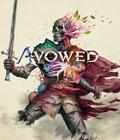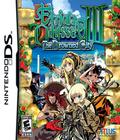The Etrian Odyssey franchise is a much-welcome return to the older days of RPGs. Games like Wizardry were among my favorite, but they gradually faded into the background in favor of plot-heavy and more cinematic RPGs. Etrian Odyssey may be built with a distinctly Japanese flavor, but at heart, it's the successor to those old-school dungeon crawlers. It has enough modern conveniences that it can't reasonably be called archaic, but it certainly approaches the RPG genre in a very different way. Etrian Odyssey III: The Drowned City is the latest game in the series, and although it is a by-the-numbers sequel that doesn't stray far from its roots, Etrian Odyssey III is arguably the best game in the franchise.
In Etrian Odyssey III, you play as a new guild that has just arrived at the Oceanside town of Armoroad, which is known for its amazing labyrinth. Adventurers from around the world come to find the rare materials hidden deep within the labyrinth. Of course, the labyrinth is not just a simple dungeon; it hides a dark secret that draws in the player's characters and forces them to make difficult decisions. While everything may look hunky-dory on the surface, some shocking surprises await in the monster-filled depths. Revealing any of these would ruin the game's more interesting moments, but suffice it to say that you shouldn't trust everyone you meet.
Etrian Odyssey III's plot is light and straightforward. It starts off slowly and eventually grows into a deeper story line. The plot never eclipses the dungeon-crawling, but it's worth mentioning because the story impacts some gameplay elements. You'll be offered a choice midway through the game that unlocks certain things and seals off others. Depending on the choice you make, you'll get one of two endings and face different foes and earn different items along the way. Even more confusing is that there is actually a hidden third ending, which is only accessible if you follow some of the most backwards logic in a game. If you want to see everything that the game has to offer, you'll have to play through a minimum of three times. It's a rather daunting task for most players, although Etrian Odyssey faithful might welcome the challenge.
Etrian Odyssey III introduces a hoard of new player classes that almost completely replaces the older class system. This is quite neat, as it goes a long way to making the game feel fresh and new. The older party combinations on which you had depended are not quite viable anymore, but there are a lot of new and more powerful options available. For example, the new prince (or princess) class is designed to support the rest of your team in unique ways. If a prince has full health at the end of a combat round, he or she will automatically heal the rest of your party. A prince can also buff your allies with elemental boosts or healing spells. Even though the class has support functions, it's actually more of a front line class. Using a prince isn't quite the same as using a traditional buffing class, and you have to change your tactics to take advantage of it. On the other hand, you have the monk, who is basically the healing class. Since the monk isn't just a glorified cleric, he is also a worthy combatant, leading to interesting choices in how and why you want to heal your party. There are also two secret classes in the game, but you'll be forced to choose which one you want to unlock.
Another nice feature of the new classes is that they can be built in multiple ways. This was an option in the previous Etrian Odyssey games, but it's more viable here. The ninja can be geared as a front-row fighter dedicated to attack multiple times, or he can be a back-row combatant who uses low-cost status effect spells. On top of that, you can also assign subclasses to characters. For example, you can have a ninja/zodiac for a fast and deadly spellcaster, or a hoplite/prince for a support character who can take a few hits. By giving you access to more skills and combinations, subclasses add a lot of variety and customization.
Dungeon exploration hasn't changed much from the previous games. Most of the differences come from the slight streamlining of the exploration process. You still have to do the mapping by hand, which is a feature that remains either delightfully retro or tedious, depending on your feelings. After playing Strange Journey, I can't help but wish the game had streamlined the automapping system. I love being able to customize my map or leave notes, but I also dislike having to draw each dungeon square that I explore.
On the plus side, some features make things more user-friendly. You can set autopilot paths for your dungeoneering party. You create a path on the map and activate it to make your characters automatically follow it. This saves a lotof time when venturing into a dungeon that you've explored multiple times. Players can set the path and leave the game until a fight occurs. It's also great for grinding materials from the various item points or setting up your characters to fight enemies to grind for experience. It may feel weird to praise the game for playing on its own, but it's an incredibly useful feature that saves a lot of time.
An interesting new feature is the ability to go sailing. Once you've completed an early part of the game, you can sail to nearby islands. You take your ship out to sea, where you can explore (generally monster-free) waters to find new fishing locations, trade routes and villages, among other things. You earn items and money for your discoveries, but you can also unlock some special quests by doing these sidequests.
While you're sailing, you're very limited in where you can go. Your dungeon-crawling heroes might not need to eat while inside the labyrinth, but they sure do while they're on the ocean. Every action you take on the sea uses up some of your provisions. You start out with only a handful of turns, and you need to upgrade the ship and supplies if you want to venture further. Once you upgrade, you can travel faster, have more food, and even fight off pirates who might otherwise impede your progress. You'll need to map trade routes and figure out how best to travel around the sea in order to use your time the most efficiently. The ocean missions provide a nice break from pounding your head against a particularly difficult stratum or boss.
Etrian Odyssey III's combat system is basically more of the same. It's a traditional turn-based combat system and features very little surprises. Your party of five works to take down enemies while conserving HP and technique points (TP). The only really new feature is the inclusion of limit breaks, which are customizable abilities for your character. Limit breaks range from causing huge damage to buffing your characters, but they're not powered by TP. Instead, you have to build up a limit bar by dealing and taking damage. Depending on the class you're using, this can take a while or be done in a couple of turns. It's an interesting addition, but it's not a complete game-changer. The major differences to combat involve the new tactics borne of the changed character classes. This keeps things fresh, as the new classes seem designed to assure the player is using interesting strategies when possible.
One of the more annoying frustrations of the earlier Etrian Odyssey games was the reliance on conditional drops. The available equipment and items depended on the rare items you sold to a store, and certain items were only available as drops from defeated foes. The trick is that you must defeat a foe in a certain way, such as defeating an enemy with an instant-kill attack. In the previous games, this was guesswork. This is slightly alleviated in Etrian Odyssey III by some friendly hints scattered throughout the game. Unfortunately, it's still something that that you need to keep track of, and that might be frustrating to players who don't want to keep a notebook while playing a handheld game. The conditions to access the third path in the game are rather convoluted, and it's very possible that players might not even realize they have a third option unless they read about it online.
Etrian Odyssey III is still a tough game. It's fair about when and where it kills you, but it isn't afraid to do so. Players who make mistakes, push their luck or get into bad situations will fall mercilessly at the claws of the many bosses. There's also a lot of backtracking and repetition. The autopathing system alleviates this, but you can and will traverse the same areas multiple times. On the plus side, the game is generally good about giving you a sense of advancement with each trip. As you push forward, you'll find new items, shortcuts and other benefits that make your next trip easier. Etrian Odyssey III is about as welcoming to new players as an Etrian Odyssey game can be. The completely revamped class system means that you're going in on equal ground with veterans, and the earlier levels are more forgiving and welcoming than those in prior games. It's still not an easy title, but someone who's curious about the franchise can start on the third title.
When compared to the previous games, Etrian Odyssey III hasn't changed much visually. The dungeons and sailing are portrayed in simple 3-D visuals, and while the graphics aren't exceptional, the art design is good. Every area has a distinct look and feel. The enemies are mostly flat artwork, although there are some nice monster designs here and there. The real star of the game is the soundtrack. Yuzo Koshiro once again returns to craft a masterful set of music for the game. The haunting melodies set the perfect tone for the dungeons and are fantastic songs in their own right. Etrian Odyssey III also has some of the best battle music I've ever heard, and while the visuals may be simplistic, the music makes every fight feel intense and exciting.
Etrian Odyssey III: The Drowned City is an easy game to recommend to fans of the Etrian Odyssey series. It's a lot more of the same, but it's been streamlined and improved in almost every way. The changes are relatively minor, but they do a lot to improve the quality of the title. The variety in class choices and story paths yields a fair amount of replay value and a lot of freedom, and the new sailing missions are fun. However, Etrian Odyssey III changes the basic gameplay very little, so I wouldn't recommend it to anyone who found the previous games to be too frustrating. The gameplay is excellent, and the dungeons are fun to explore, but only if you enjoy that particular style. Fans should pick up Etrian Odyssey III before it becomes another Atlus title that you can only buy on eBay.
Score: 8.0/10
More articles about Etrian Odyssey III: The Drowned City












 The embodiment of adventure and discovery in the purest sense, Etrian Odyssey III transports gamers to a sparkling oceanic paradise filled with atmospheric dungeons to chart and survey, vast watery expanses to sail across, and rumors of a sunken city to investigate.
The embodiment of adventure and discovery in the purest sense, Etrian Odyssey III transports gamers to a sparkling oceanic paradise filled with atmospheric dungeons to chart and survey, vast watery expanses to sail across, and rumors of a sunken city to investigate.






































